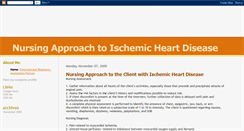Nursing Approach to Ischemic Heart Disease
OVERVIEW
NURSINGAPPROACHISCHEMICHEARTDISEASE.BLOGSPOT.COM RANKINGS
Date Range
Date Range
Date Range
LINKS TO WEB SITE
Tuesday, November 29, 2005. Ogunmefun, MBBS, MPH. The incidence of hypertension increases with age and is more common in African Americans than in whites. It is more common in younger men than in women, although this difference does not exist after the age of 55 and is reversed after the age of 75. Alcohol and drug use, NSAIDs, ephedrine.
Nursing Approach to a Client in Shock. Monday, November 07, 2005. Nursing Approach to a Client in Shock. Check presence of wounds;.
Nursing Care Plan for Abdominal Trauma. Tuesday, November 08, 2005. Nursing Care Plan to the Client with Abdominal Trauma, Acute Abdomen and Peritonitis. 1 Assess for history of the injury, onset and progression of the symptoms. 3 Assess abdomen wall for presence of wounds and hematomas. 4 Assess vital signs, CVP, fluid balance and urine output.
Careers for Nurses in the Biopharmaceutical Indust. Monday, November 21, 2005. Careers for Nurses in the Biopharmaceutical Industry. By Kristin Hudasek, B. On the other hand considering current trends in Biopharmaceutical Industry it is expected that major boom in new pharmaceutical products will occur within the next two years. Please note this information does not give any medical advice.
Tuesday, November 22, 2005. In temperate countries flu epidemics hit in fall and winter seasons. Where as in tropical regions, influenza can be contracted throughout the year. Hong Kong Flu was the last and least pandemic in the 20th century that began in Hong Kong in 1968 and spread to the U. S the same year and lasted unt.
Tuesday, November 22, 2005. The single best way to prevent the flu is to get a flu vaccine each fall, but there are other measures that can help protect against the flu. Who should get the flu shots? The Am.
Monday, November 21, 2005. As presented by Brigette Hales, M. The earlier advances in asthma research led to the development of a variety of bronchodilator therapies. The mechanism of action of each type of bronchodilator varies, however they are generally employed to provide rapid relief during acute asthma attacks by way of airway smooth muscle relaxation.
WHAT DOES NURSINGAPPROACHISCHEMICHEARTDISEASE.BLOGSPOT.COM LOOK LIKE?



NURSINGAPPROACHISCHEMICHEARTDISEASE.BLOGSPOT.COM HOST
WEBSITE IMAGE

SERVER OS AND ENCODING
I found that this domain is operating the GSE server.PAGE TITLE
Nursing Approach to Ischemic Heart DiseaseDESCRIPTION
Nursing Approach to Ischemic Heart Disease. Monday, November 07, 2005. Nursing Approach to the Client with Ischemic Heart Disease. 1 Gather information about all facets of the clients activities, especially those that precede and precipitate attacks of anginal pain. 2 Assess the risk factors in the clients history and modifications possible to reduce risk. 3 If chest discomfort is present at the time of the interview, further collection of data is delayed until pain and dysrhythmias are resolved. 2 Med.CONTENT
This web page nursingapproachischemicheartdisease.blogspot.com states the following, "Nursing Approach to Ischemic Heart Disease." We saw that the webpage said " Monday, November 07, 2005." It also said " Nursing Approach to the Client with Ischemic Heart Disease. 1 Gather information about all facets of the clients activities, especially those that precede and precipitate attacks of anginal pain. 2 Assess the risk factors in the clients history and modifications possible to reduce risk. 3 If chest discomfort is present at the time of the interview, further collection of data is delayed until pain and dysrhythmias are resolved."SEEK SIMILAR DOMAINS
Nursing Approach to Motoric Bowel Disorders. Tuesday, November 01, 2005. Nursing Approach to the Client with Motoric Bowel Disorders. 1 Assess for personal and family history, congenital defects, previous abdominal trauma, autoimmune and allergic states, medications usage, previous bowel infections or disorders. 2 Collect information of complaints that brought client to the hospital. 3 Obtain history of onset and progression of symptoms. 6 Assess diagnostic tests and procedures for abnormal values.
Nursing Approach to Neoplastic GI tract. Tuesday, November 01, 2005. Nursing Approach to the Client with Neoplastic process of the GI tract. 1 Assess for personal and family history, presence of previous GI damage, age, occupation, presence of other neoplastic changes, diet and nutritional habits, usage of certain medications. 3 Obtain history of onset and progression of symptoms. 4 Obtain information of signs of neoplastic changes in GI system. 5 Pain and restlessness, related to diagnosis of malignant .
General Nursing Approach to a Client during Preope. Monday, November 07, 2005. General Nursing Approach to a Client during Preoperative Period. 1 Assess for history of current health problems and factors that would influent recovery. 2 Perform complete physical assessment to identify potential health problems. 3 Assess diagnostic tests and procedures for abnormal values. 4 Teach the client t.
Monday, November 07, 2005. Nursing Approach to the Client with Pulmonary Embolism. 3 Assess for pleural pain, pain on inspiration, and the presence of crackles on auscultation. 1 Ineffective breathing patterns related to anxiety. 2 Impaired gas exchange related to loss of functioning lung tissue. 3 Anxiety related to pain.
Monday, November 07, 2005. Nursing Approach to the Client with Pulmonary Hypertension. 1 One of the most important nursing interventions is to identify those clients who are at high risk of developing pulmonary hypertension, such as those with COPD, pulmonary emboli, CHF, and mitral valve disease. 2 Obtain history from the client regarding onset and progression of symptoms and existing cardiac or pulmonary disease. Please note this information does not give any.